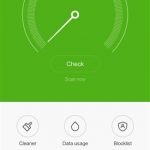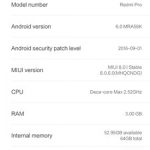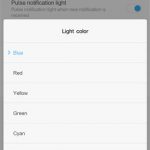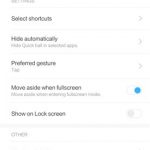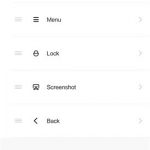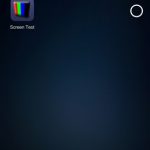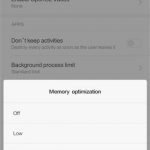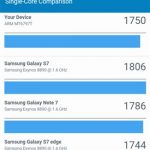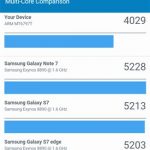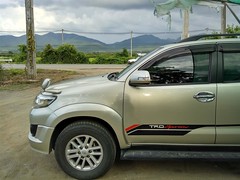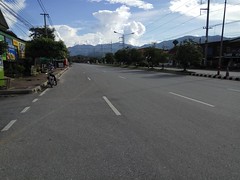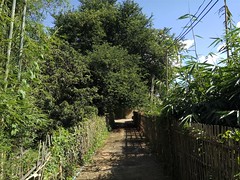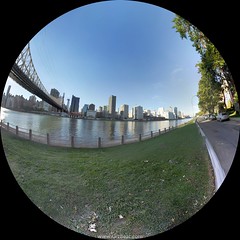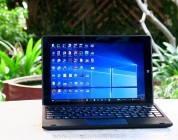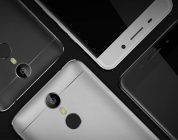Helio X25 MTK6797T Redmi Pro review
The Redmi Pro is Xiaomi’s new mid-priced mobile. That is, it wouldn’t be considered a budget device by the China phone crowd, but it wouldn’t be considered a flagship either.
In our eyes, this is the upgrade to Redmi Note 3 Pro, as the Redmi Note 4 Pro carries nothing new other than a bit more powerful SoC and higher Antutu score.
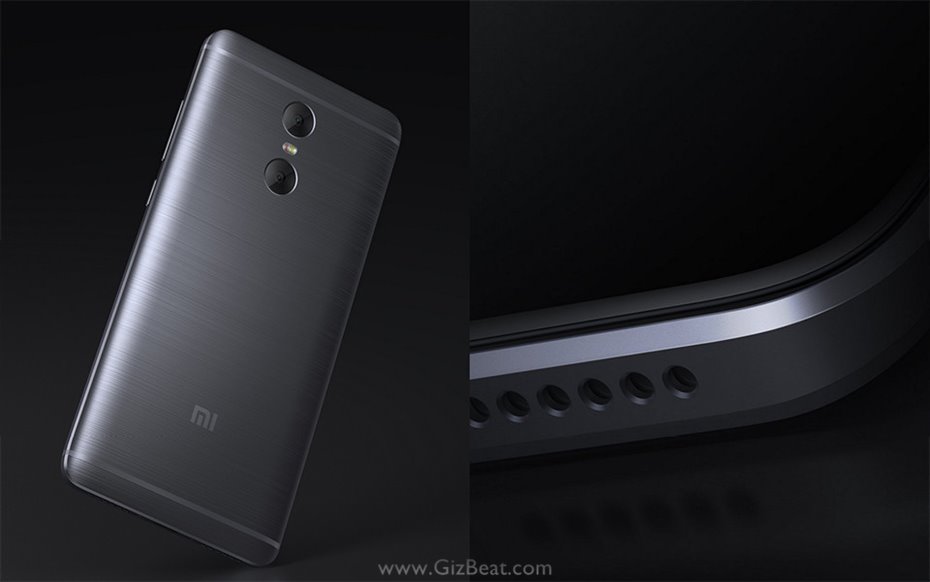
MTK6797T Redmi Pro dual rear cameras
Perhaps the first thing we notice about Redmi Pro specwise is the dual rear cameras. The promise of this feature is that we can achieve dSLR like bokeh (blur) with small sensors, due to the differing field of view (FOV) between the two sensors (you can read more about that here (opens in new tab)).
We’ll get into this later in the review, with samples. For those looking for the quick and dirty, we wouldn’t buy Redmi Pro based on this feature. But, the Sony IMX258 is one of the better sensors available in mobiles in this price range, and camerawise the Redmi Pro can be considered based on IMX258 alone.
MTK6797T Redmi Pro style
The Redmi Pro looks awesome. Xiaomi has finally gotten around to using 2.5D glass for the front, but it’s the back that blows us away.
Instead of the iPhone 6 soft matte aluminum with off-color top and bottom style that’s been kicking around in every other mobile recently released, the Redmi Pro takes on a much more bold, industrial look, with a back that looks like premium brushed steel.
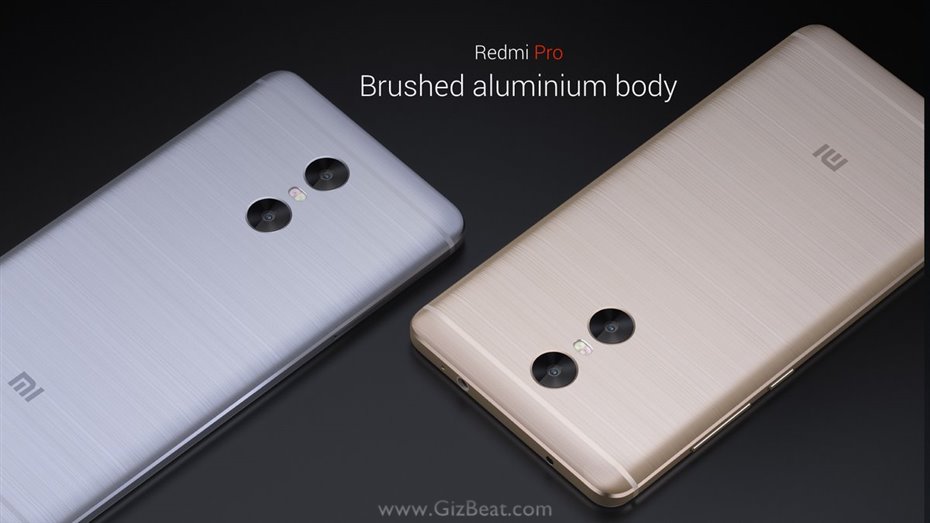
The metal back is polished to a classy sheen which keeps it shunning dirt and makes it easier to clean.
The sides and bottom speaker holes are CNC machined and look great as well. Build is solid, with no loose spots or creaks.
Helio X25 Redmi Pro review display
One of the touted features of the Redmi Pro, and one which differentiates it from Redmi Note 3 Pro, is the OLED display.
This is probably the most difficult aspect of the Redmi Pro to evaluate. The Redmi Pro display is great in some areas and disappointing in others.
At about 10 inches you can begin to see the individual pixel points in small, thin text and edges of icons. The text issue can somewhat be mitigated by increasing system font size and/or changing system font.
Whether this is a hardware limitation of the display, or a font smoothing/anti-aliasing issue with MIUI 8 it’s hard to say for sure. It’s not a huge problem as the display manages to look great regardless, but it keeps the display from being a top dog.
When the display is at 10 inches or further, the issue is far lessened, but those who often use their phone close to the face and are used to retina displays may want to consider the issue.
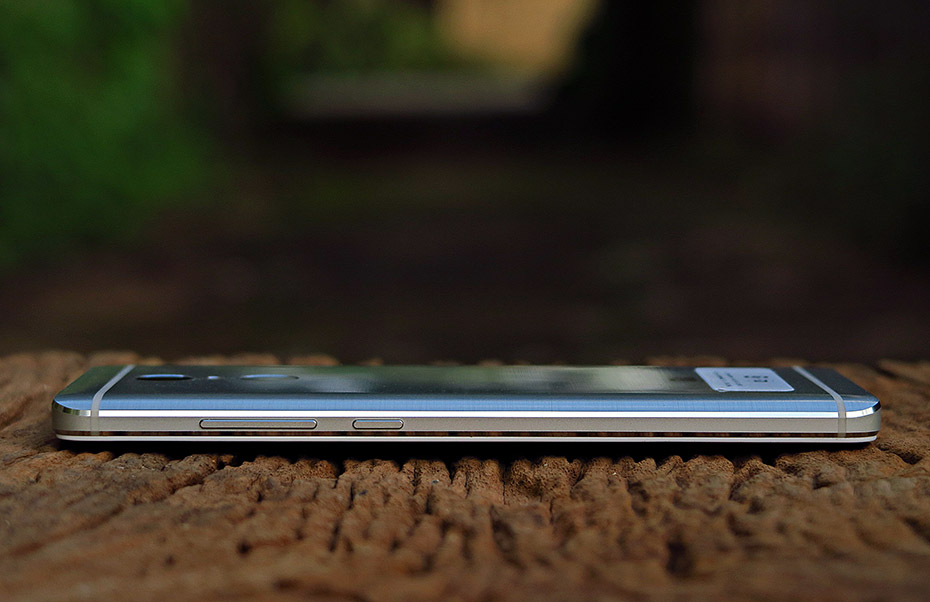
Otherwise it’s a beautiful display:
- Colors are deep and rich
- There’s no shimmer at minor angles or otherwise
- Color and contrast viewing at extreme angles remains excellent
- Brightness is perfectly even across the frame with no vignetting or greying
- Max brightness hits an excellent 445lux at 100%
- Lowest brightness is a great 4lux
There’s also the argument that OLED can help with battery life.
Helio X25 Redmi Pro review OS
The OS on RP is Android 6.0 Marshmallow overlayed with MIUI 8.0. Initially the Redmi Pro came to us with MIUI 7, but an MIUI 8 OTA downloaded and installed without issue.
- Tools
- Built-in security
- Permission settings
- MIUI 8
- Android 6 MIUI 8
- Notification LED settings
MIUI 8 makes some interesting and welcome changes compared to MIUI 8:
Screenshots
Upon taking a screenshot, the screenshot shrinks, and unobtrusively floats to the upper right corner where it sits for 2 seconds waiting for an action, e.g. send to a friend, or an app for annotation etc…
Settings
This is superficial, but interesting and welcome nonetheless: While many China brands have rushed to copy MIUI’s multi-colored circular icons in settings, MIUI 8 has done pulled a u-turn and made all settings a modern, mature, flat gray, Font Awesome style.
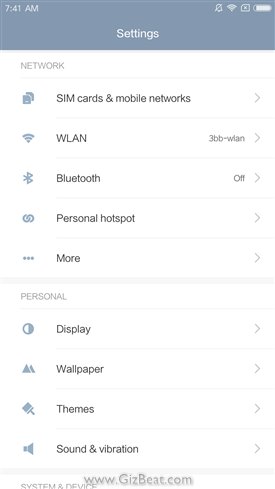
Flat gray icons
Quick tiles
Quick tiles are now by default available in a single horizontal scrolling row right above notifications. This feature is very welcome, as the swipe down, then swipe left to get to quick tiles was silly; it seemed Xiaomi was doing this just to be different, not due to any practical reasoning.
In addition there was no two-finger pull down to get immediately to quick tiles. Now they’re bam right there with a single swipe. If you prefer the old style MIUI way, it can easily be switched to legacy mode in settings.
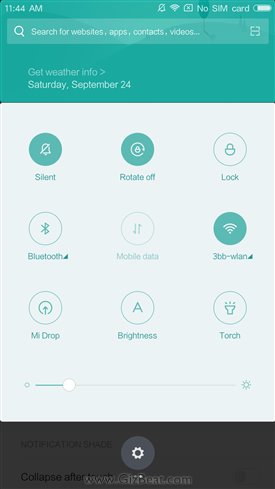
Quick settings legacy
Quick ball
The quick ball is an optional setting that puts a small ball with multiple user choice functions. Upon tapping the ball, various options come out that allow you to for example take a screenshot, or jump to a specific app. Meizu has used a similar quick ball for quite a while now. Generally we leave this off. It can be moved, but no matter where it’s at it will eventually get in the way. Some users may find it useful though.
- Quick ball on/off
- Flat gray icons
- Quick ball
Second Space
Similar to Windows, MIUI 8 allows you to set up an entirely different space for a 2nd user, or for yourself if you want for example a relax/work space with only apps for playing and chilling, and a space for work related only apps so you don’t get distracted by games, Facebook, etc… while in work mode.
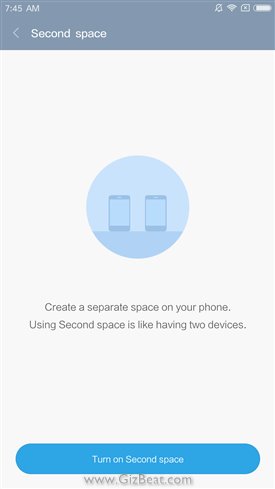
Second space
Dual apps
This allows you to setup some apps with dual accounts. For example if you have two WeChat or two Facebook Messenger accounts you want to be signed into at once.
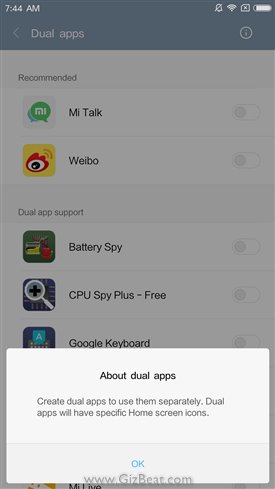
Dual apps
Some other interesting MIUI options
- Child Mode: allows you to set only specific apps to be available
- App lock: allows you to set a security code for specific apps.
- Memory optimization: allows the user to choose how finicky MIUI is with letting apps fall out of memory. By default it’s set to medium. You can also set it to off, which theoretically means MIUI shouldn’t push apps out of memory until that memory is absolutely required.
- Themes: one thing we really like about MIUI is the ability to easily change themes. These themes are true, full theme changes which change style in most areas of your mobile, not just the icons and wallpaper.
- Child mode
- App lock security
- Memory optimization
- Theme downloads
Xiaomi Redmi Pro ROM storage
The Redmi Pro comes in 32GB and 64GB storage options. Both versions allow you to insert a TF SD card for expanding storage. The 32GB version should be enough for most all users. Note the setup is dual-SIM or single-SIM+TF SD. You can’t use dual-SIM+TF SD.
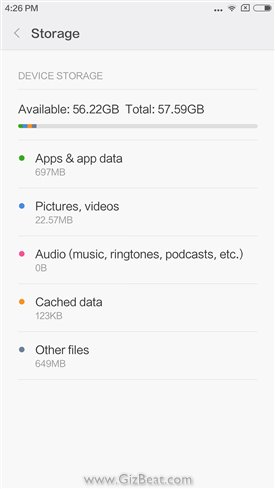
Storage (64GB ver)
Redmi Pro other notes:
- System transitions and animations are fluid
- Quick typing is fluid and without hangups
- Switching to between apps in memory is quick
- LED gently pulses and has multiple color options available for different alert types
- Fast scrolling is great with appropriate friction and acceleration
- Slow scrolling is butter
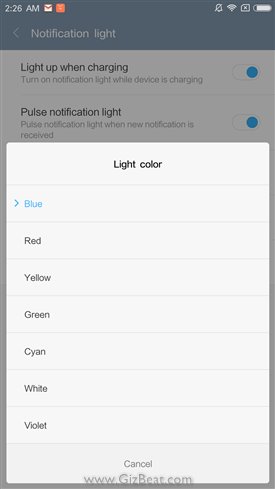
Notification LED settings
Languages
Languages available are only English and Chinese in the stock ROM. There is an eu ROM available, but this requires additional steps some users may not be comfortable with, e.g. unlocking bootloader, flashing with SP flash tool or through TWRP, etc… The process is not difficult, but there could be a bit of a learning curve involved for those not familiar with these things.
There may be an official Global ROM available in the near future as with happened with the Redmi Note 3 Pro, however there’s no guarantee of this.
Google Play Store
For many users, Google Play may need to be manually installed. This is a very simple, 5 minute process, without any need for root or installing Gapps through recovery.
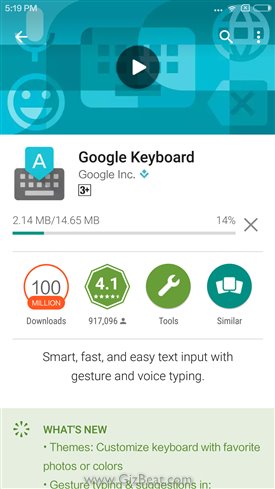
Google Play Store
Xiaomi Redmi Pro root
We had to problem with Xiaomi Redmi Pro unlocking the bootloader, booting Xiaomi Redmi Pro TWRP, and Xiaomi Redmi Pro rooting.
SoC power
Xiaomi Redmi Pro carries the current flagship MTK SoC, MediaTek Helio X25 MTK6797T. While not as powerful as Qualcomm’s or Samsung’s top dogs, it’s well beyond powerful enough to do whatever you ask of it, quickly.
| MediaTek Helio X20 MTK6797 MT6797 | MediaTek Helio X25 MTK6797T MT6797T | MediaTek Helio X10 MTK6795 MT6795 | MediaTek Helio P20 MTK6757 MT6757 | MediaTek Helio P10 MTK6755 MT6755 | |
|---|---|---|---|---|---|
| Process | 20nm | 20nm | 28nm | 16nm | 28nm |
| CPU | 2x Cortex-A72 @ 2.1GHz ~ 2.3GHz 4x Cortex-A53 @ 1.85GHz 4x Cortex-A53 @ 1.4GHz |
2x Cortex-A72 @ 2.5GHz 4x Cortex-A53 @ 2.0GHz 4x Cortex-A53 @ 1.55GHz |
64-bit Octa-Core 8x Cortex-A53, up to 2GHz | 8x Cortex-A53, up to 2.3GHz | 8x Cortex-A53, up to 2.0GHz |
| Memory | 2x LPDDR3 POP 933MHz up to 4GB eMMC 5.1 |
2x LPDDR3 POP 933MHz up to 4GB eMMC 5.1 |
2x LPDDR3 933MHz PoP | Up to 2 x LPDDR4X 1600MHz (up to 6GB) + 1x LPDDR3 933Mhz (up to 4GB) + eMMC 5.1 | 1x LPDDR3 933MHz up to 4GB eMMC 5.1 |
| Camera | 32MP @ 24fps / 25MP @ 30 fps w/ZSD Dual ISP w/Improved 3A/denoise / demonsalc/sharpness/Native3D |
32MP @ 24fps / 25MP @ 30 fps w/ZSD Dual ISP w/Improved 3A/denoise / demonsalc/sharpness/Native3D |
20MP @ 30FPS w/ Dual ISP | Up to 24MP at 24FPS w/ZSD, 12bit Dual ISP, 3A HW engine, Bayer & Mono sensor support | 21MP@24fps / 16MP@30fps w/ ZSD Dual ISP w/improved 3A/denoise/ demosaic/sharpness |
| Video Decode | 4Kx2K 10 bit 30fps H.264/265/VP9, 30% power improvement |
4Kx2K 10 bit 30fps H.264/265/VP9, 30% power improvement |
4Kx2K 30FPS H.264/265 | Up to 4Kx2K 30fps H.264/265 | 1080p 30fps H.264/265 |
| Video Encode | 4Kx2K 30fps H.265 w/HDR, 40% power improvement |
4Kx2K 30fps H.265 w/HDR, 40% power improvement |
4Kx2K to 30FPS H.265 | Up to 4Kx2K 30fps H.264 | 1080p 30fps H.264 |
| Graphics | ARM Mali 780MHz | ARM Mali 850MHz | IMG G6200 700 MHz | Mali T-880 MP2 900MHz | ARM Mali-T860 MP2 700MHz |
| Display | WQXGA 2560x1600 60fps FHD 1920x1080 120fps w/12 HW Blending Layer |
WQXGA 2560x1600 60fps FHD 1920x1080 120fps w/12 HW Blending Layer |
WQXGA 2560x1600 | FHD 1920x1080 60fps. 2x DSI for dual display | FHD 1920x1080 w/ 12 Blending Layer |
| Modem | LTE FDD/TDD R11 Cat-6 with 20+20 CA (300/50Mbps) DC-HSPA+, TD-SCDMA,EDGE CDMA2000 1x/EVDO Rev.A (SRLTE) LTE/GPS Co-clock Supported |
LTE FDD/TDD R11 Cat-6 with 20+20 CA (300/50Mbps) DC-HSPA+, TD-SCDMA,EDGE CDMA2000 1x/EVDO Rev.A (SRLTE) LTE/GPS Co-clock Supported |
LTE FDD/TDD R9 Cat-4 DC-HSPA+ 42/11 Mbps, TD-SCDMA, EDGE | LTE FDD TDD R.11 Cat.6 with 2x20 CA. C2K SRLTE. L+W DSDS support | LTE FDD/TDD R11 Cat-6 with 2x20 CA (300/ 50Mbps), DC-HSPA+, TD-S CDMA, EDGE CDMA2000 1x/ EVDO Rev. A (3.1/1.8Mbps, SRLTE) LTE/GPS Co-clock Supported |
| RF | Single RF for LTE/WCDMA/TD/EDGE/C2K 14/14 Primary/Diversity RX Ports |
Single RF for LTE/WCDMA/TD/EDGE/C2K 14/14 Primary/Diversity RX Ports |
Single RF for LTE/WCDMA/TD/EDGE 8/8 Primary/Diversity RX Ports | Single RF for LTE 2x20 CA/WCDMA/TD/EDGE/C2K 14/14 Primary/Diversity RX Ports | Single RF for LTE 2x20 CA/WCDMA/TD/EDGE/C2K 14/14 Primary/Diversity RX Ports |
| Connectivity | Integrated Wi-Fi 802.11ac w/throughput up to 280Mbps GPS/Glonass/Beidou w/ Improved TTFF & Drift, BT/FM |
Integrated Wi-Fi 802.11ac w/throughput up to 280Mbps GPS/Glonass/Beidou w/ Improved TTFF & Drift, BT/FM |
External MT6630 Wi-Fi 11ac/GPS / Glonass /Beidou, BT/FM | WiFiac/abgn (with MT6630). GPS/Glonass/Beidou/BT/FM. | Wi-Fi abgn w/ throughput up to 90Mbps / GPS /Glonass/Beidou w/ improved TTFF & Drift, BT/FM |
Xiaomi Redmi Pro Antutu
Redmi Pro MTK6797T Helio X25 Antutu total is 91427.
The Antutu breakdown:
- Total: 91427
- 3D: 17590
- UX: 39357
- CPU: 26792
- RAM: 7688
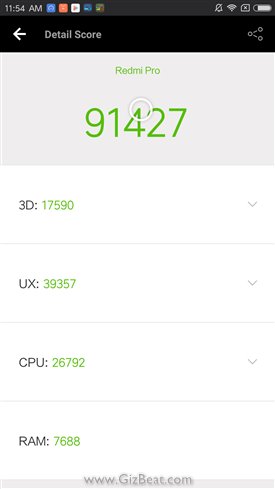
Redmi Pro Antutu MT6797T Antutu
Xiaomi Redmi Pro Geekbench 4
Redmi Pro MT6797T Helio X25 Geekbench 4 is 1750 for single and 4029 for multi. This puts it right on par with Galaxy S7 and OnePlus 3 in single, and on par with OnePlus 3 in multi as well.
- Geekbench 4
- Geekbench single
- Geekbench multi
Xiaomi Redmi Pro battery charging
The Redmi Pro has a big 4050mAh battery. With a battery this size and given the price of the phone, we would expect no less than 2A charging, and here the RP doesn’t disappoint, featuring a quick charge system pushing RP from dead to 95% in 2 hours.
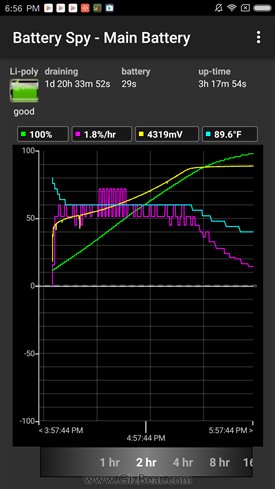
Beautiful curve 2h charging
Xiaomi Redmi Pro SOT battery life test screenon
Redmi Pro screenon SOT time lasted 9 hours on our 140lux YouTube WiFi 720P streaming test. An excellent result for a slim phone such as this. It means power users will have absolutely no problem getting through a full day or possibly two, typical users should easily see two days or possibly three, and light users will see three to five days.
Dual rear camera pictures
As mentioned in the opening of the review, the dual rear cameras wouldn’t be a strong reason to purchase the Redmi Pro. They sometimes hit, and often miss, but this is dependent on which situations you use the feature. If used properly, it can be compelling.
Where it fails is with smaller objects from a distance, with objects of similar colored backgrounds, or objects that have holes in them or are fuzzy (think uncombed hair etc…). Xiaomi also recommends being within 2 meters of the subject.
Where it sometimes hits well is with bigger objects such as cars, and with people with contrasting backgrounds. If the background and foreground are of a similar color, you may end up with some areas blurred that should be in focus and vice versa.
Additionally, we noticed that Google Camera “blur” feature for some situations often works better than the stereo dual-cam shots.
After some time with the phone you’ll notice what situations will hit and which won’t, so it then becomes a more useful feature and less of a fuss to use. We can also control the amount of blur through software emulation of aperture.
The cat
We see the shot with the cat shot hit well. Quite pleasing, and similar to what you’d see from a dSLR. The right ear melds with the background a bit, but it’s very tough situation as both the ear and the concrete are in a similar color and brightness range, and ears tend to be a bit fuzzy.

The lady
Moving on to the lady. Impressive except for the hair at the top. But, here we have a lot going on… The hair a bit fuzzy and the white building with the blue sky.
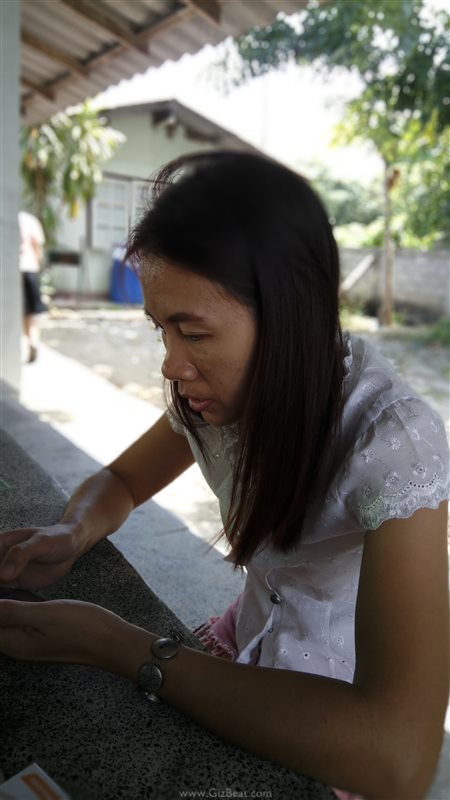
The kids
With the kids, given all that’s going on, again the stereo camera does an okay job. The girl’s forehead on the right is mistakingly blurred, as are the girl’s fingers. Considering all that’s going on here though, it’s difficult to fault the results. If it had just been the boy in the shot, this would have turned out well.

The truck
Now we have the truck which came out nearly perfect. This is an optimal situation with a single object with clean lines in the foreground and contrasting colors in the background.
The first truck shot is set at the highest aperture and makes it so both the foreground and background are in focus. This could be handy very handy in situations where want the entire picture in crisp focus; most phone cameras are set to a fixed aperture of f2, which may add shallow depth of field (DOF) when we don’t want it.
The 2nd truck shot was post-focus adjusting so the background is in focus and the foreground out. The 3rd truck shot is adjusting synthetic aperture so the blur is more intense. Images #2 and #3 of the truck are just to show a point; you’re probably not going to want to present an image with the truck blurred and the background in focus in this situation.
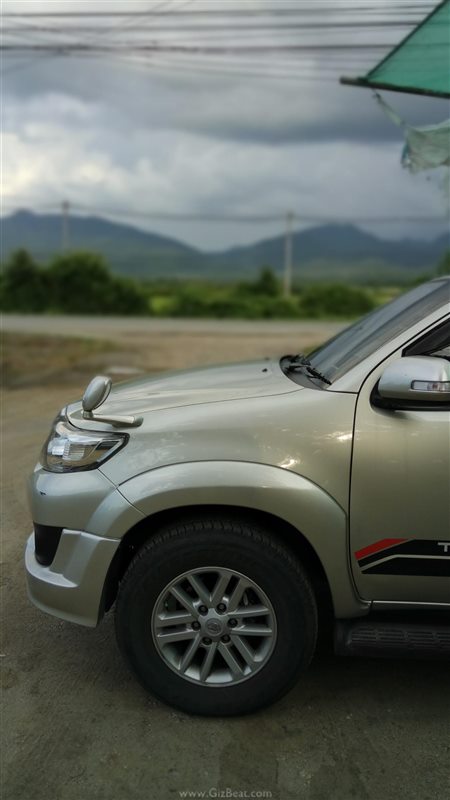
Finally we have what we’re looking for, with the truck nice and in focus and the background with creamy bokeh. Maybe it’s a bit much for some’s taste, and if that’s the case, you can dial just dial it back…See the final shot.
These adjustments post shot are very easy to make and just take a couple of seconds each.
Google Camera vs Redmi Pro stereo mode
Let’s take a look at Google Camera vs RP dual cameras. In this test, Google camera clearly comes out as the winner in regards to subject separation. Google Camera actually does a fantastic job. They have clean lines, while the RP stereo mode isn’t quite sure what’s what.
We also see the bokeh is much stronger in the Google Camera shots. This can be adjusted in both the Redmi Pro Stereo post processing and with Google Camera post processing. In this particular image, the problem with increasing bokeh is that the errors with subject separation also increase. Likewise, decreasing the bokeh would improve the errors.
On the bright side, at least with the first comparison shot, the RP stereo mode shot is better exposed, though this could likely be adjusted by post processing / brightening the Google shots fairly easily.
Also note, this is a single test situation, not extensive.
- Redmi Pro Stereo
- Google Camera
- Redmi Pro Stereo
- Google Camera
Post focus
After the shot is taken in “stereo mode”, we can still adjust the amount of blur, and perhaps quite usefully we can also change where in the photo the focus point should be.
For example if we want the truck blurred and the background in focus (see pics), we simply tap on the background and re-save the picture. We’ve also noticed that by going in after the shot is taken and readjusting focus point and blur amount, we can sometimes achieve a better result than the initial image.
Overall, we’re impressed with the stereo camera. It’s not perfect, but after using it for awhile you will find many opportunities to fairly effortlessly turn out dSLR like shots. Take a look at the gallery below, particularly at the image of the truck and mountains.
3D
There’s also an interesting 3D mode which dynamically changes the angle of view based on how the phone is tipped or turned. Not by a huge amount, but enough to be cool. It’s a nice little gimmick that should have kids and ladies wowing.
In conclusion regarding the stereo camera mode: It has its uses, but we wouldn’t base our decision to buy the Redmi Pro on this feature.
Xiaomi Redmi Pro Sony IMX258 camera picture sample image gallery
We first tested the IMX258 a ways back in the Mi4C. As mentioned in the opening of the review, this is a very good mid-range sensor and is considered a good choice in mobiles in the $200 range, right up there with Samsung S5K3P3 which is in the Redmi Note 3 Pro and Ulefone Future.
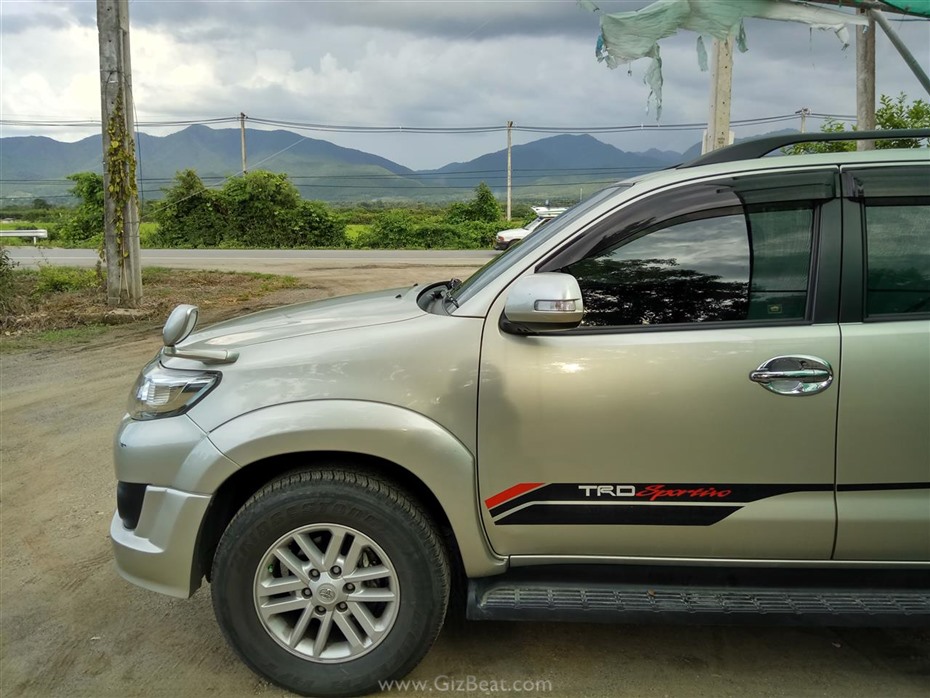
Pictures usually come out with very pleasing colors. HDR is useful without going over the top. Pictures are sharp across the frame. The camera is well beyond adequate for social sharing, and good enough for making largish prints as well.
Metering
Metering is determining what the current light conditions are, then adjusting aperture, ISO, and shutter speed to achieve desired brightness.
Smartphone apps and cameras generally do this automatically for us. Notice when you point at something that’s dark and taking up the majority of the frame, the camera will adjust to attempt to bring that dark area to appropriate brightness so it can be seen when the image is taken. Likewise, when you point the camera at something very bright, it will adjust settings to darken so the image isn’t all blown out highlights.
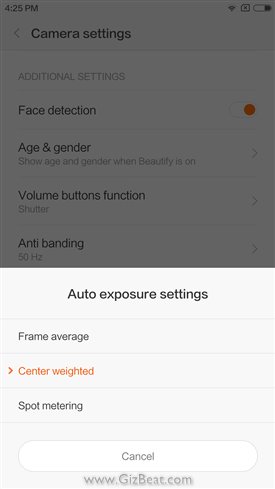
Exposure settings
One thing we like about the Xiaomi camera app is the ability to effectively choose a metering mode. There are three metering modes available: evaluative or “Frame average”, which evaluates the entire frame; spot, which puts most exposure consideration towards the focus point you tap on the display; and center-weighted, which evaluates exposure based heavily towards what’s in the center of the image.
Fingerprint resistant
One of our favorite things about the Redmi Pro is that it carries an oleophobic coating on the rear camera glass. This coating makes it impressively resistant to fingerprints and smudges, and makes it much easier to clean, as grease and oils don’t adhere as they do with non-coated glass.
Gallery
The images in the gallery are unedited other than resize to 1280×720 and saving at 75% jpg quality. You can compare the Sony IMX258 Redmi Pro images to others in our flickr album gallery (opens in new tab).
Xiaomi Redmi Pro review frequency support
2G: GSM 900/1800/1900MHz
3G: WCDMA 850/900/1900/2100MHz
4G: FDD-LTE 850/900/1800/2100/2600MHz
This gives the Redmi Pro mostly worldwide 2G GSM, worldwide 3G / WCDMA / H / H+, and 4G / LTE support for Asia / Euro / UK.
Xiaomi Redmi Pro review components
- OTG: working without issue (tested bluetooth mouse, keyboard, generic gamepad)
- Compass: working without issue (tested with Z device tester and Google Maps)
- Gyroscope: working without issue (tested with Google Camera panorama)
- IR remote: working without issue (tested on Panasonic aircon)
- Ambient light sensor: working without issue and OS appropriatly adjusting display brightness
Xiaomi Redmi Pro gyroscope
Wonderfully, Xiaomi includes a gyroscope with all of it’s recent model phones, all the way back to Redmi 2, and possibly before. It may not sound like a big deal to users who are used to more expensive mobiles, but China manufactures often don’t include it in their phones. Here are a few gyroscope shots taken with the Redmi Pro. They can be fun.
Additionally, the Gyroscope can be used with stargazing apps such as Sky Map for improved accuracy.
Xiaomi Redmi Pro LED notification
Notably, the LED notification works perfectly on the Redmi Pro. Many China brands still haven’t gotten this down right.
On the Redmi Pro the LED only flashes notification when the display is off (or battery low screen on or off). As soon as the display is turned on, the notification light should then stop. Regardless of if the notifications are cleared or not, when the display is turned off again, the LED should remain off unless a new notification comes through. Good job Xiaomi. Not difficult, but many China brands are still struggling with this simple logic.
There are a plethora of colors to choose from for different notification types.
Xiaomi Redmi Pro review GPS
GPS signal strength on the Redmi Pro is excellent, locking within seconds, and with 5-7 satellites generally staying from mid-30’s to mid-40’s and the other locked satellites in the 20’s.
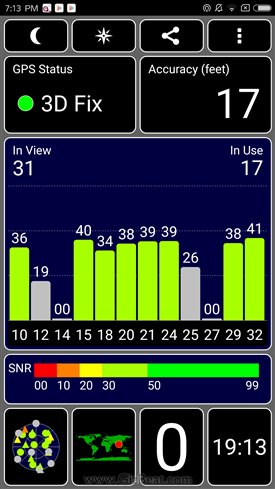
GPS SNR
Xiaomi Redmi Pro WiFi
WiFi signal strength on the RP is fantastic; about as good as it gets. With distance to spare, the Redmi Pro reached what we consider excellent: 144ft/44m staying steady and strong with a cinder block wall between the mobile and a $20 home router
Xiaomi Redmi Pro external speaker
The external speaker on the Redmi Pro is very good. Well beyond adequate in terms of loudness, clarity, and depth. And, significantly better than phones in a similar price range such as Ulefone Future and Umi Super.
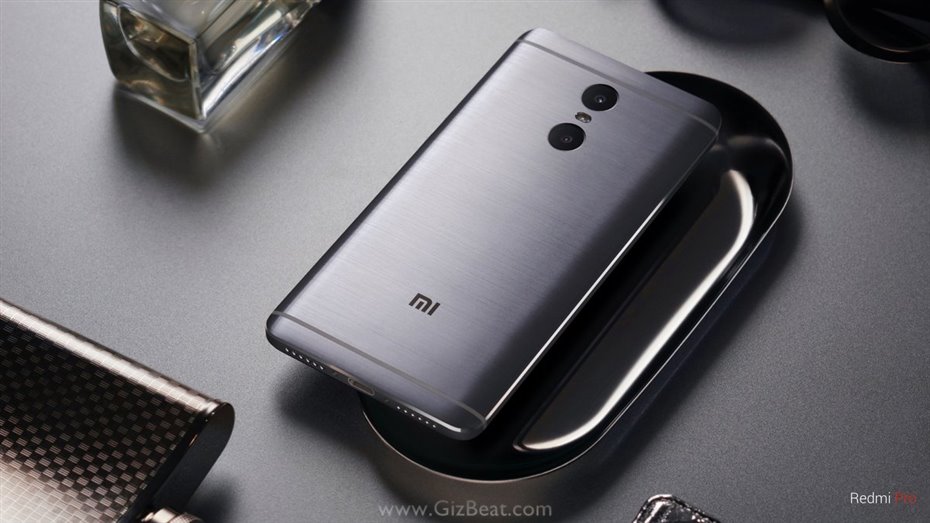
MT6797T Xiaomi Redmi Pro review summary conclusion
It’s a joy to pickup and use, and it looks awesome– The perfect man phone stylewise with the brushed steel-looking back. It’s as powerful as mobiles costing far more, has a good display, excellent battery life, fast charging, OTG, gyroscope, compass, infrared remote, the Sony IMX258 camera sensor, Android 6, and everything working properly, including the “small stuff” that can add up to be a big hassle in some mobiles.
The Redmi Pro is what other China brands should be manufacturing to compete, and it’s unfortunate we see brands that have been around for a long while now still looking to get off as cheap as they possibly can while surviving on hype marketing.
If you’re considering spending $200 ballpark on a phone, Redmi Pro should be at the top of your list.
If you’ve got a few more bucks and can bump into $250-300 territory, we recommend the Xiaomi Mi5.
While bang for the buck the RN3P is still our top pick, if the stainless steel style of the Redmi Pro is calling to you, you like deep, rich color displays, and find the stereo camera setup intriguing, you can’t go wrong here.
If looking at spending a bit less, consider the RN4.



